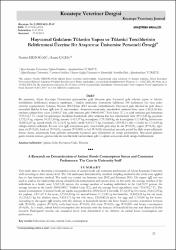Hayvansal Gıdaların Tüketim Yapısı ve Tüketici Tercihlerinin Belirlenmesi Üzerine Bir Araştırma: Üniversite Personeli Örneği
Abstract
Bu araştırma, Afyon Kocatepe Üniversitesi personelinin gelir düzeyine göre hayvansal gıda tüketim yapısı ve tüketici
tercihlerinin belirlenmesi amacıyla yapılmıştır. Tabakalı örnekleme yöntemiyle belirlenen 348 katılımcıya yüz yüze anket
yöntemi uygulanmıştır. Çalışma, Haziran 2012-Şubat 2013 arasında yürütülmüştür. Hayvansal gıda tüketimi ile gelir düzeyi
arasındaki ilişkiler ki-kare (χ2) testi ile incelenmiştir. Araştırma sonucunda, hanelerdeki ortalama birey sayısı 3,36±1,26 kişi,
ortalama çalışan birey sayısı 1,64±0,57 kişi, aylık ortalama gelir 3000±1009,7 Türk Lirası (TL) ve aylık ortalama gıda harcaması
715±342,7 TL olarak hesaplanmıştır. Katılımcı hanelerinde yıllık ortalama kişi başı tüketimlerin sütte 29±12,45 kg, peynirde
5,7±2,33 kg, yoğurtta 10,1±3,35 kg, ayranda 5,4±3,07 kg, tereyağında 1,75±0,83 kg, süt kaymağında 1,1±0,45 kg, kırmızı ette
18,84±6,28 kg, kanatlı etinde 15,12±4,32 kg, balık etinde 9,42±3,73 kg, yumurtada 129±45,24 adet ve balda ise 1,7±0,94 kg
olduğu tahmin edilmiştir. Ki-kare testi (χ2) sonuçlarına göre, hanelerdeki gelir artışı ile süt (P<0,05), yoğurt (P<0,05), sığırdana
eti (P<0,05), balık eti (P<0,01), yumurta (P<0,001) ve bal (P<0,05) tüketimleri arasında pozitif bir ilişki tespit edilmiştir.
Sonuç olarak, araştırmada hane gelirinin artmasıyla hayvansal gıda tüketiminin de arttığı gözlenmiştir. Hayvansal gıdaların
gerek tüketim miktarı, gerekse tüketim tercihlerinde katılımcıların gelir ve eğitim seviyesinin etkili olduğu belirlenmiştir. This study aims to determine consumption status of animal foods and consumer preferences of Afyon Kocatepe University
staff according to their income level. The 348 participant determined by stratified sampling method in this study were applied
face to face interview method. The study was carried out between June 2012 and February 2013. Chi-square (χ2) test was
used to analyze the relationship among animal foods consumption and income level. In this study, the average number of the
individuals in a family were 3,36±1,26 person, the average number of working individuals in the 1,64±0,57 person, the
average income in the family 3000±1009,7 Turkish Liras (TL), and the average food expenditure were 715±342,7 TL. The
annual consumption of animal foods per capita was predicted as 29,0±12,45 L for milk, 5,7±2,33 kg for cheese, 10,1±3,35 kg
for yoghurt, 5,4±3,07 L for ayran, 1,75±0,83 kg for natural butter, 1,1±0,45 kg for butterfat, 18,84±6,28 kg for red meat,
15,12±4,32 kg for chicken meat, 9,42±3,73 kg for fish meat, 129,0±45,24 piece for eggs and 1,7±0,94 kg for honey.
According to chi-square (χ2) results, with the increase in household income has been found a positive correlation between
milk (P<0,05), yoghurt (P<0,05), cattle-beef meat (P<0,05), fish meat (P<0,01), egg (P<0,001) and honey consumption
(P<0,05). As a result, animal food consumption also increased with the increase of household income was observed in this
research. Participants' income and education levels were determined to be effective on animal foods consumption and
preferences.
Source
Kocatepe Veteriner DergisiVolume
8Issue
1Collections
- Cilt 8 : Sayı 1 [13]



















